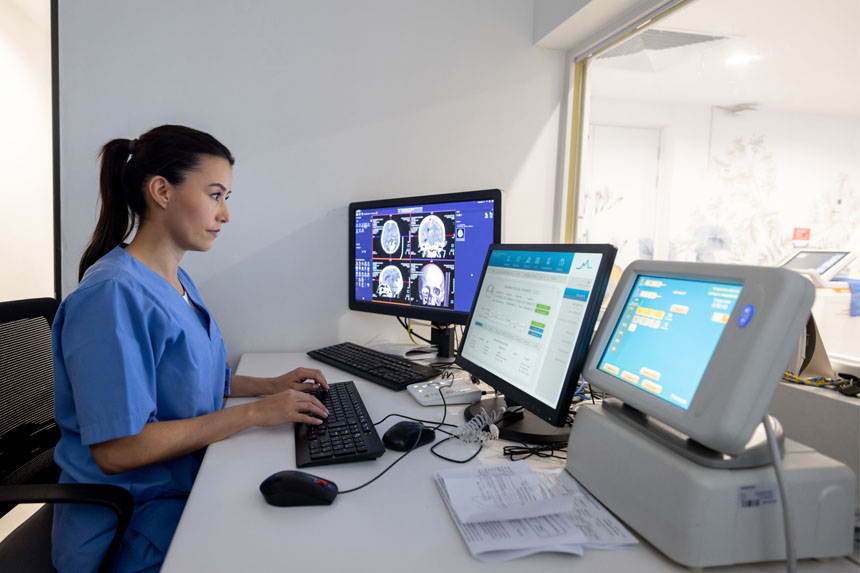Radiology is a medical specialty that uses various forms of imaging techniques to assess and diagnose a patient’s health. It’s broadly divided into three main areas: diagnostic radiology, interventional radiology, and radiation oncology. Each field uses imaging to detect medical conditions, guide procedures, or deliver targeted treatments.
Radiology constantly evolves as technology advances to improve imaging capabilities, diagnostic precision, and the speed at which accurate results are delivered. As such, the medical device industry must stay on top of emerging trends in radiology. The following radiology trends reflect these advances and offer insight into the current, and future, radiology market.
Trend #1: AI and ML are driving innovation
The medical device industry is experiencing a wave of innovation as medtech companies continue to integrate AI and ML into their products. Since 2015, the number of FDA approvals for AI-enabled devices has surged, reflecting this growing trend.
AI and ML have become so integral to new medical devices that the FDA’s Center for Devices and Radiological Health (CDRH) has released specific guidance for AI and ML-based software as medical devices. This includes a framework for how these devices should be approved, monitored, and adapted as they evolve.
The integration of AI and ML into medical devices, particularly in diagnostic imaging, has the potential to enhance diagnostic accuracy and reduce human error. These AI-driven tools may help detect issues that could otherwise be missed, improving overall diagnostic precision. Additionally, AI could streamline processes, increasing the speed of diagnoses and helping to standardize procedures, which might lead to faster and more reliable patient care.
Radiology has seen some of the greatest benefits from AI tools, with 75% of FDA-approved AI-enabled medical devices being used in this specialty, making it the field most impacted by these technological advancements.
Trend #2: A rise in hyperspectral and molecular imaging
Hyperspectral and molecular imaging are two techniques that give providers a closer look at a patient’s health. Hyperspectral imaging captures images at different wavelengths, allowing doctors to see and analyze specific tissues or substances in more detail. Molecular imaging uses targeted probes to highlight specific molecules, making it easier to visualize certain biological targets. As the need for more detailed and accurate diagnoses grows, these imaging methods are becoming more common in medical practice.
One example is X-ray spectroscopy, which offers high-resolution information about the elemental makeup of tissues and organs. Another is micro-CT, a type of molecular imaging that produces detailed images of small structures. These advanced imaging techniques allow physicians to detect diseases earlier and deliver more targeted treatment.
These methods are especially helpful for challenging cases, such as infants and neonates with suspected congenital heart defects. Getting a clear CT scan of young children can be difficult, but photon-counting computed tomography (PCCT), provides a better alternative, offering higher-quality imaging at a lower radiation dose. PCCT can even be used alongside ultrasound and MRI to create 3D reconstructions of the heart, making it a valuable tool for accurate diagnosis.
The rise of hyperspectral and molecular imaging brings several key benefits. First, they improve diagnostic capabilities, helping doctors detect conditions earlier and prioritize treatment. Second, they allow for more precise treatment targeting, particularly at the molecular level, opening the door to new therapies. Finally, these technologies provide a way to diagnose conditions that, until now, had no reliable imaging methods.
Ultimately, the rise in hyperspectral and molecular imaging is likely to change how we diagnose and treat diseases, offering physicians more effective tools to help patients.
Trend #3: Understand emerging needs and opportunities to innovate with data
As advancements in imaging technologies continue to shape the field of radiology, it’s important to also consider the most common procedures performed today, which highlight the areas where innovation can have the greatest impact.
The most common radiology procedure, accounting for 9.2% of procedures, is bilateral screening mammography (CPT code 77067), according to Definitive Healthcare data. The second most common, at 6.2%, is screening digital breast tomosynthesis, bilateral (CPT code 77063), a more advanced for of mammography used to detect breast cancer.
Next in line are two types of chest X-rays, which make up 6.2% and 4.9% of procedures, respectively (CPT codes 71046 and 7105). These tests are often used to diagnose respiratory conditions and infections, including viruses.
As shown by the distribution these common procedures, breast cancer screening is the leading reason for diagnostic imaging, followed by imaging for respiratory conditions. Understanding which procedures are most common can highlight the areas where healthcare providers could most benefit from innovation as well as opportunities for targeted marketing in these fields.
Learn more
As diagnostic imaging continues to evolve, trends like the integration of AI and the rise of hyperspectral and molecular imaging are paving the way for earlier diagnoses and more precise treatments. These advancements are reshaping the radiology landscape and opening new opportunities for innovation, particularly in the medical device field.
If you’re looking to target radiologists or imaging centers, explore our products and solutions Or, start a free trial to gain a better understanding the market and uncover opportunities for your device or service.


